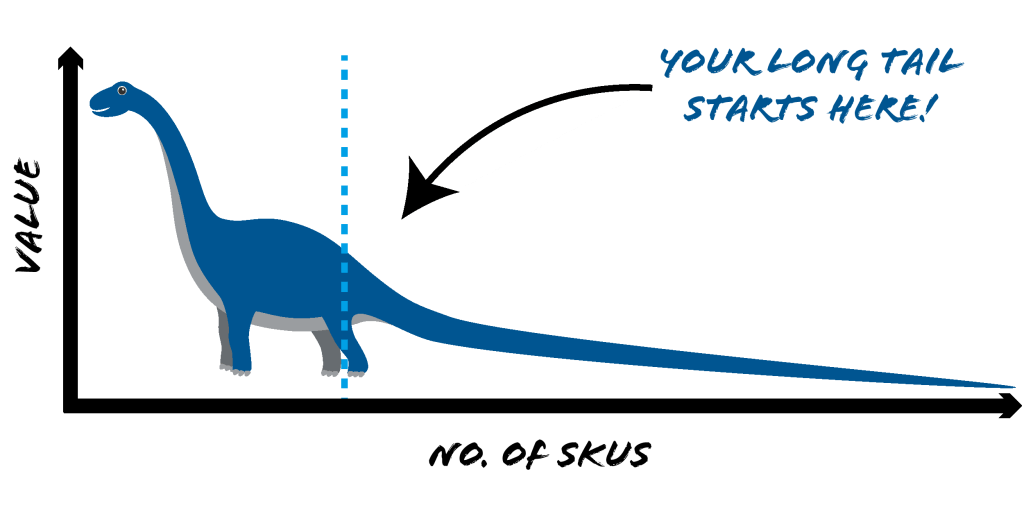Future of Long Tail Businesses | Basics
New age technologies are making long tail businesses a new reality.
Hello, 👋
The pace of technological advancements has increased manifold. Now, we witness a major disruptive technology every year, making impossible things possible. Long tails are one such example.
In this article, we will explore the rise of long-tail businesses and how you can create side gigs around them.
Garvit Sahdev enjoys understanding ideas that shape our world. The Thoughtful Tangle is an initiative to share this journey and experience with his friends who love to do the same. He selects one idea and dives deep into it to understand its basics, relevance, impact and opportunities around it. The thoughtful tangle is special because 👇
📝 One long article per idea. We call it ‘The Basics’.
📝 Multiple unique insights. Separate small articles for special ‘Insights’.
🧑🤝🧑 Experts perspective. Check out ‘Insiders’
Let’s start now!
What is a long tail?
Long tail refers to those products, services, and markets which are high in number but low in value for any business. These are not in high demand and are not mainstream. These constitute those 80% of the 20:80 principle of Pareto which brought only 20% results for any business.

Why is it called a long tail?
Because the graph of Value vs Products/Services/Markets looks like the long tail of an animal. 😊😊

Why was long tail not lucrative in the past?
The Pareto principle, which calls all businesses to focus on their 20% products, services or markets, made the long tail non-lucrative in the past.
But why have businesses decided to focus on their 20% portfolio? Because they have costs of running the businesses which are distributed equally against their complete portfolio of products and services. Now these costs are of different types e.g. distribution costs, marketing costs, human resource costs, management costs, raw material costs, capital costs, etc. Businesses by just focusing on 20% of their portfolio saved more than 50% of these costs.

But why were these costs high?
The simple answer is that a lot of business functions were inefficient. There was a lack of automation. Distribution models were traditional. Businesses need to show products physically to customers before they can sell them. Demand forecasting was difficult. The working capital requirement was huge due to long distribution channels.
Does a long-tail market exist?
YES, new products, niche products, ancillary products, seasonal products, and speciality products (think “green beer”) all fall in the category of long-tail products.
So basically, in the case of long-tail products/services, the cost of value generation, communication and distribution was higher than the value being generated. Thus, doing business in this area is unviable.
Why is long tail becoming lucrative now?
Technology in multiple forms has brought down the costs of value generation, communication and distribution lower than the value being generated.
In its first phase of transformation, technology reduced the cost of aggregation of products and services allowing businesses to sell a lot of them. The large scale of operation allowed businesses to achieve positive unit economics. Amazon is one great example of this transformation.
For Amazon, expanding its assortment with long-tail SKUs comes at a minimal cost, leveraging its established e-commerce infrastructure. When delving into niche categories or products with limited track records, Amazon often requires vendors to send just one unit for listing on the website. While Amazon Prime necessitates minimum stock levels and reliable fulfilment, the Amazon Marketplace has proved immensely beneficial for vendors seeking product exposure. Amazon has essentially become a testing ground for emerging products and categories like smart home devices. Consequently, customers are drawn to Amazon for its wide array of products and unique offerings. Additionally, Amazon's customer reviews and Q&A sections hold even greater significance for long-tail items.
In the second phase of this transformation, new technologies are making it feasible without the need for aggregation. Now, if I want to sell T-shirts of a particular design, I can do that easily by outsourcing most of the business operations at least cost. I will not be selling lots of T-shirts but still, I can be profitable.

Are there any specific technologies which are making it possible?
NO, all technologies which have helped businesses in doing their work more efficiently at less cost have contributed towards this. Let’s name some driving forces.
Data-driven technologies
AI-driven technologies like LLMs, etc.
Automation technologies
Platforms like Amazon, Netflix, etc.
Digital Public Infrastructures like ONDC, UPI, etc
Why should you look for a long-tail business?
Less competitive space
Long tail products are generally of high margins
Less price-sensitive customers
Opportunity to become market leaders in niche segments
Ideal for new businesses as the cost of failure is low
What does the future look like?
Micro market phenomenon: The term typically refers to the emergence or development of small, specialized markets within larger market contexts. These micro markets often cater to niche or specific customer needs, preferences, or demographics.
Democratisation businesses: The term typically refers to companies or initiatives that aim to democratize access to products, services, or information that were previously limited to certain groups or elites. These businesses often leverage technology or innovative business models to make goods or services more accessible, affordable, or easier to use for a broader population.
House of Businesses: A house of businesses is a business model where a company owns and manages multiple distinct businesses. Each operates independently, with its unique identity, target market, and marketing strategy.
Businesses with easy entry and exit: It refers to markets where it is relatively straightforward for new firms to establish themselves and for existing firms to leave. In such environments, entrepreneurs can swiftly start new ventures, while struggling or unprofitable businesses can exit without significant barriers.
Business moats will move near to customers: The community of customers becomes moats of the long tail businesses. Customers might become shareholders and advise in day-to-day operations.
What are the new categories of businesses emerging due to the unlocking of long-tail markets?
If we see a business from a macro perspective, customer needs being fulfilled and customers are the two key things which are unique to every business or which cannot be outsourced. Rest all the business functions can be outsourced. Now the opportunities which are coming up due to the unlocking of long-tail markets are related to this concept only.
One set of opportunities is fulfilling the niche needs of niche customers which was not feasible till now. For example, its super easy now a days to open a sustainable fashion brand which is catering to small population of sustainable fashion customers present all over India. It’s easy because the cost of doing business has reduced drastically over the last few years. To capture such opportunities, we should look out for niche markets which were unfeasible due to high business costs but can become feasible with some disruption.
Another set of opportunities lies in building a business which can support or provide service to lakhs of businesses who are operating in niche markets. For example, providing logistics services to lakhs of fashion brands who are operating throughout the world.
SOMEONE CAN BENEFIT FROM IT
If you find this post helpful, we would be grateful if you could take a moment to share it with others who might benefit from it. Your kindness and support mean a lot to us.
DYNAMIC CONTENT
No one knows how deep a rabbit hole can go.
All our posts are regularly updated as soon as new information becomes available. We also keep note of the questions asked by our readers and add their answers to the article. So, stay curious and ask questions in the comments.
Questions to be answered soon:
What’s in it for multiple stakeholders like Government, large-scale businesses, founders, VCs, policymakers, etc?
Last updated on 22 February 2024
ABOUT THE AUTHOR
Hey everyone, I'm Garvit Sahdev 😎. I'm on a mission to gain a deeper understanding of the world, and to develop solutions that can trigger significant global change.
My curiosities span various domains including food, business theories, material science, market size calculations, economics, politics, and sports, etc. 🧐
Professionally, I have a diverse background spanning startups, consulting, policy development, market research, system building, ISO, colour physics, nanomaterial synthesis, textile chemistry, etc. 🐘





